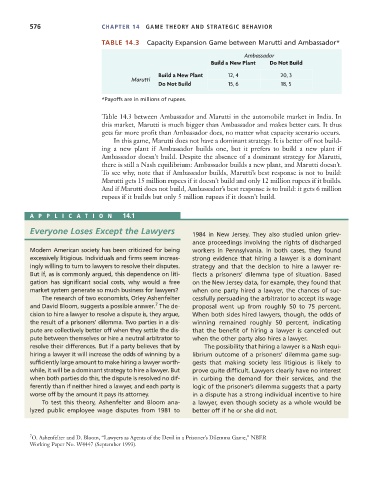Page 602 - Microeconomics, Fourth Edition
P. 602
c14gametheoryandstrategicbehavior.qxd 8/6/10 8:22 AM Page 576
576 CHAPTER 14 GAME THEORY AND STRATEGIC BEHAVIOR
TABLE 14.3 Capacity Expansion Game between Marutti and Ambassador*
Ambassador
Build a New Plant Do Not Build
Build a New Plant 12, 4 20, 3
Marutti
Do Not Build 15, 6 18, 5
*Payoffs are in millions of rupees.
Table 14.3 between Ambassador and Marutti in the automobile market in India. In
this market, Marutti is much bigger than Ambassador and makes better cars. It thus
gets far more profit than Ambassador does, no matter what capacity scenario occurs.
In this game, Marutti does not have a dominant strategy. It is better off not build-
ing a new plant if Ambassador builds one, but it prefers to build a new plant if
Ambassador doesn’t build. Despite the absence of a dominant strategy for Marutti,
there is still a Nash equilibrium: Ambassador builds a new plant, and Marutti doesn’t.
To see why, note that if Ambassador builds, Marutti’s best response is not to build:
Marutti gets 15 million rupees if it doesn’t build and only 12 million rupees if it builds.
And if Marutti does not build, Ambassador’s best response is to build: it gets 6 million
rupees if it builds but only 5 million rupees if it doesn’t build.
APPLICA TION 14.1
Everyone Loses Except the Lawyers
1984 in New Jersey. They also studied union griev-
ance proceedings involving the rights of discharged
Modern American society has been criticized for being workers in Pennsylvania. In both cases, they found
excessively litigious. Individuals and firms seem increas- strong evidence that hiring a lawyer is a dominant
ingly willing to turn to lawyers to resolve their disputes. strategy and that the decision to hire a lawyer re-
But if, as is commonly argued, this dependence on liti- flects a prisoners’ dilemma type of situation. Based
gation has significant social costs, why would a free on the New Jersey data, for example, they found that
market system generate so much business for lawyers? when one party hired a lawyer, the chances of suc-
The research of two economists, Orley Ashenfelter cessfully persuading the arbitrator to accept its wage
7
and David Bloom, suggests a possible answer. The de- proposal went up from roughly 50 to 75 percent.
cision to hire a lawyer to resolve a dispute is, they argue, When both sides hired lawyers, though, the odds of
the result of a prisoners’ dilemma. Two parties in a dis- winning remained roughly 50 percent, indicating
pute are collectively better off when they settle the dis- that the benefit of hiring a lawyer is canceled out
pute between themselves or hire a neutral arbitrator to when the other party also hires a lawyer.
resolve their differences. But if a party believes that by The possibility that hiring a lawyer is a Nash equi-
hiring a lawyer it will increase the odds of winning by a librium outcome of a prisoners’ dilemma game sug-
sufficiently large amount to make hiring a lawyer worth- gests that making society less litigious is likely to
while, it will be a dominant strategy to hire a lawyer. But prove quite difficult. Lawyers clearly have no interest
when both parties do this, the dispute is resolved no dif- in curbing the demand for their services, and the
ferently than if neither hired a lawyer, and each party is logic of the prisoner’s dilemma suggests that a party
worse off by the amount it pays its attorney. in a dispute has a strong individual incentive to hire
To test this theory, Ashenfelter and Bloom ana- a lawyer, even though society as a whole would be
lyzed public employee wage disputes from 1981 to better off if he or she did not.
7 O. Ashenfelter and D. Bloom, “Lawyers as Agents of the Devil in a Prisoner’s Dilemma Game,” NBER
Working Paper No. W4447 (September 1993).

